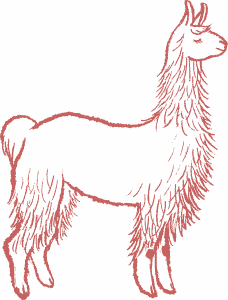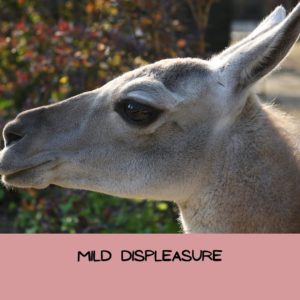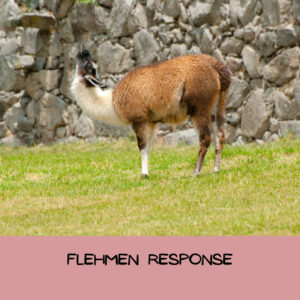
If you provide care for camelids (in this resource, camelid(s) is referring only llamas and alpacas) at your animal sanctuary, then having a good understanding of their body language is vital to a successful relationship and care practices for them. While camelids have different vocalizations that communicate important information, their body language can provide vital insight into their emotional states and health, if you are able to interpret them properly! This resource is part of a series on camelid body language and provides a brief introduction to the different ways camelids communicate with their heads and necks. We previously published a resource that goes into the different ways camelids communicate with their ears and another on tails. Through this series, you will learn to identify different meanings behind ear/head/tail/body positions, and how context and the combination of these body positions can provide a fuller picture of what is being expressed. Let’s take a general look at body language before taking a closer look at head and neck positions:
Body Language
Body language can help you better understand your resident’s wishes and emotional and mental states. Understanding a resident’s body language can allow you to catch early signs of illness or recognize social issues among the herd that may be negatively affecting them. Body language also tells you a lot about a resident’s comfort level around different individuals and during different situations. This allows caregivers to tailor these situations and their own behaviors to better meet the needs of the individual better. In camelids, there are a number of things to pay close attention to: their ears, their head, their neck, their tail, and their overall body position. While each of these areas can provide information on an individual, the whole of them read together will provide the best overall interpretation. But what do you look for in terms of head and neck positioning, and what might it mean? Let’s take a closer look!

Head And Neck Positioning In Camelids
A llama’s head is generally more elongated, and an alpaca’s is shorter. Their necks are long, though some individuals will have shorter necks than others. In addition to being used for grazing, their heads and necks can convey a lot of information to others in their herd, as well as to the humans caring for them. If you care for camelid residents, you may have noticed their heads facing up towards the sky at some point. Or maybe you have noticed someone holding their head and neck lower than their body and crouching. What do those positions and behaviors mean? In general, the higher someone is holding their head back, tilting towards the sky, the more displeased they are in some way with the situation.

Abnormal Head And Neck Conformation And Positioning
Some camelids may be born with congenital defects that cause their neck to be crooked or cause them to hold their neck differently. Others may have sustained an injury that changed the conformation of their neck, which may cause abnormal neck and head movement. There are neurological disorders that can affect a camelid’s ability to move their head and neck normally. Their heads and necks may not move the same as a typical camelid’s, and care must be taken to learn what movement their heads and necks are capable of and what their position may mean for that individual. Obviously, these cases will require specialized knowledge of the individual in order to understand what they may be “saying” through body language. Understanding camelid neck and head placement can also help you detect new injuries or illnesses and treat them immediately. Applying a general concept of camelid communication through head and neck placement may not be effective for individuals with abnormal positioning and could lead to misunderstandings and an unhappy resident. Remember, while learning about species-specific behaviors is vital, so is learning about the individual!
While the full meaning of head and neck positioning comes with context and understanding other aspects of camelid body language, there are some basic positions to know. You will see a bit later how the combination of head and neck and ear/tail/body position can provide a fuller picture of what their body language is “saying”!
Neutral/Relaxed
A camelid’s head will generally be level, without any apparent tension, and lifted above the body line by the neck. Of course, this can look different while they are eating, drinking, or using the communal poop pile. This can also be the case if they are feeling relaxed. A neutral camelid’s neck will be above the horizontal line, around 70 degrees or so, though this varies from individual to individual.



Alert/Curious
If a camelid is mildly curious, their head is generally still horizontal, but there may be more tension in their neck, lifting the head above the body line, though the neck may only lift up partially if they have been eating.



Alarmed
If a camelid becomes alarmed, their head may remain level but be lifted high, their neck straightening and holding obvious tension.

Displeased/Warning
If a camelid resident is uncomfortable, feels threatened by something about a situation, or wants to warn someone away, their head may start tilting back, as will their ears. Their tail will rise as well. Their neck position may not change a whole lot during this time but may straighten with their head tilted back if they move onto serious displeasure at the situation.


Serious Displeasure/Confrontational
If a resident feels particularly displeased and feels the need to confront someone, their head will usually be held back, facing up to the sky, with their ears back and tail up. While all the above should be taken seriously, and steps should be taken to lower any discomfort or anxiety, this combination of positions is a grave warning that they are especially displeased, and whatever is happening to make them feel threatened or uncomfortable should stop immediately before they take defensive (spitting) or offensive (kicking, biting, or charging) measures in an attempt to stop whatever it is that is upsetting them.
While in a defensive posture, their neck may be held up fairly vertically while holding their head up in a position allowing them to spit. If they feel they need to chase or charge someone, their neck may stretch out horizontally in front of them while they charge the perceived threat.


Questioning/Submissive
A submissive or questioning individual’s head may point a bit down or remain fairly level but be held low by the neck, lower than the body. Their tails will generally flip all the way up and over, laying against their back when signaling their submissive status to a dominant herd member or when crias approach their mothers to nurse. This may also be observed when an individual is uncertain and may be seen to approach someone.

Flehmen Response
There may be a time you see a camelid resident with their neck lowered, but with their head back and up, and their ears may be laid back, but their tail held in a neutral position. This is not a sign of displeasure or something to be concerned about. This is the flehmen response, where certain species are using their vomeronasal organ in response to certain scents. This is often in response to the scent of urine and helps them determine the reproductive status of their herdmates, though you may see this response to other scents as well!

The Full Picture
In order to get the full picture of what a camelid resident is trying to “say”, it is important to understand the context of the situation you are witnessing, as well as how the tail, ear, and head and neck are positioned, in addition to their overall body posture. While the above is a great introduction to camelid body language and can certainly help you have a better idea of what your camelid residents may be experiencing or expressing, you will learn through this series on body language that nuance can be important, and knowing about ear, tail, AND head position will allow you to have a clearer picture of that is being “said”. Check out the accompanying resources about ear and tail positions. You can also learn more about camelid vocalizations here!
SOURCES:
Exotic Animal Care And Management | Google Books
Alpaca And Camelid Behavior | Kush Veterinary Clinic
Medicine And Surgery Of Camelids | Murray Fowler, Google Books
Human Ability To Interpret Alpaca Body Language | Journal Of Veterinary Behavior
Behavioral Clues For Detection Of Illness In Wild Animals: Models In Camelids And Elephants








